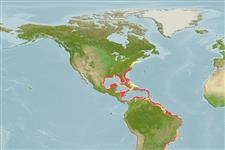>
Tetraodontiformes (Puffers and filefishes) >
Tetraodontidae (Puffers) > Tetraodontinae
Etymology: Sphoeroides: Greek, sphaira = ball + Greek, suffix, oides = similar to (Ref. 45335).
Eponymy: Lorentz Spengler (1720–1807) was a zoologist employed by Det Kongelige Danske Kunstkammer, Copenhagen, as Assistant to the Keeper (1765). [...] (Ref. 128868), visit book page.
More on author: Bloch.
Environment: milieu / climate zone / profondeur / distribution range
Écologie
marin; saumâtre récifal; profondeur 2 - 70 m (Ref. 26999). Subtropical; 43°N - 30°S, 98°W - 34°W
Western Atlantic: Massachusetts, USA to Santa Catarina, Brazil (Ref. 57756). Replaced by Sphoeroides marmoratus in the eastern Atlantic (P. Wirtz, pers. comm. 10/04).
Taille / Poids / Âge
Maturité: Lm ? range ? - ? cm
Max length : 30.0 cm TL mâle / non sexé; (Ref. 26999); common length : 12.0 cm TL mâle / non sexé; (Ref. 3821)
Rayons mous dorsaux (Total) : 9. 11-14 sharply defined round black spots on head and lower side of body. The numerous tan lappers on the rear part of the body and distinct spots along the lower side make it unmistakable (Ref. 26938).
Body shape (shape guide): fusiform / normal.
Abundant in all inshore habitats where there is adequate cover, such as seagrass beds and reef flats. Feeds on mollusks, crustaceans and echinoderms (Ref. 36453), also on worms and zooplankton larvae (Ref. 131040). Generally common (Ref. 9710). Traded as an aquarium fish at Ceará, Brazil (Ref. 49392).
Life cycle and mating behavior
Maturité | Reproduction | Frai | Œufs | Fécondité | Larves
Robins, C.R. and G.C. Ray, 1986. A field guide to Atlantic coast fishes of North America. Houghton Mifflin Company, Boston, U.S.A. 354 p. (Ref. 7251)
Statut dans la liste rouge de l'IUCN (Ref. 130435: Version 2025-1)
Menace pour l'homme
Poisonous to eat (Ref. 3821)
Utilisations par l'homme
Pêcheries: commercial; Aquarium: Commercial
Outils
Articles particuliers
Télécharger en XML
Sources Internet
Estimates based on models
Preferred temperature (Réf.
123201): 22.5 - 28, mean 25 °C (based on 472 cells).
Phylogenetic diversity index (Réf.
82804): PD
50 = 0.5000 [Uniqueness, from 0.5 = low to 2.0 = high].
Bayesian length-weight: a=0.01738 (0.01356 - 0.02226), b=2.90 (2.83 - 2.97), in cm total length, based on LWR estimates for this species (Ref.
93245).
Niveau trophique (Réf.
69278): 3.3 ±0.2 se; based on diet studies.
Résilience (Réf.
120179): Haut, temps minimum de doublement de population inférieur à 15 mois (Preliminary K or Fecundity.).
Fishing Vulnerability (Ref.
59153): Low vulnerability (20 of 100).
🛈
Nutrients (Ref.
124155): Calcium = 32.6 [10.8, 107.5] mg/100g; Iron = 0.68 [0.34, 1.43] mg/100g; Protein = 19.7 [17.5, 21.9] %; Omega3 = 0.262 [0.123, 0.509] g/100g; Selenium = 15.9 [7.1, 34.3] μg/100g; VitaminA = 42.4 [13.0, 139.6] μg/100g; Zinc = 0.993 [0.654, 1.519] mg/100g (wet weight);
